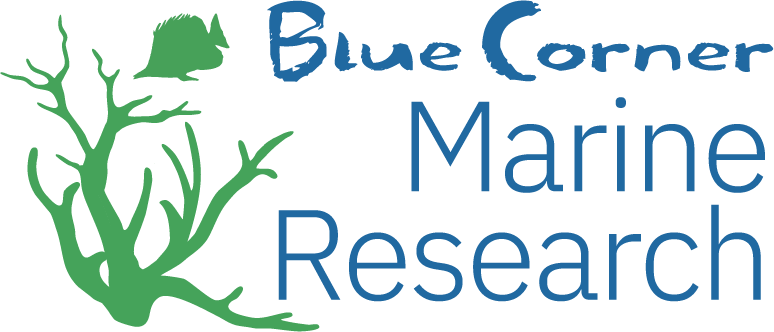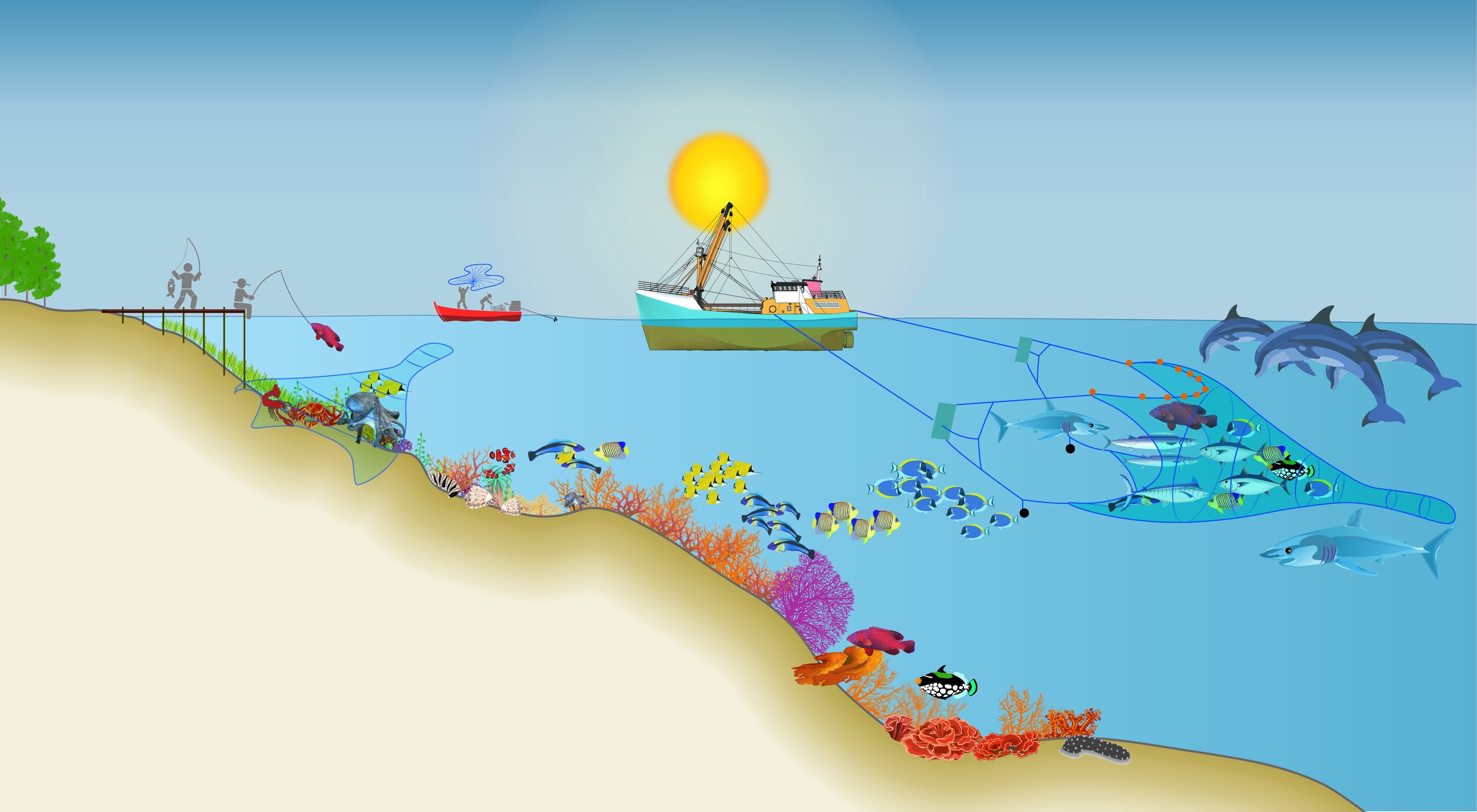Sustainable Fisheries
A fishery is composed of three elements – the resource (fishery stock – eg. Tuna); the habitat and the people who are involved in the capture, processing and sale of the resource. Modern fisheries management focuses on:
Regulation and conservation of the harvested resource
Protection of the habitat associated with the resource
Although oceans cover about 70% of the Earth’s surface, they are not uniformly populated with fish. The most productive areas are closely associated with continental land masses where about 90% of commercial harvest occurs. This is due to both the accessibility of these areas to boats from land and their high productivity. Water in these areas is sufficiently shallow to allow light penetration and support large populations of phytoplankton – the base of marine food webs
Fish species depend upon their surrounding and supporting ecosystems, which are affected by fishing activities, other human activities, as well as natural processes. Fishing can impact marine ecosystems by:
Catching unwanted species (bycatch);
Causing physical damage to benthic habitats;
Disrupting food chains.
Other human activities unrelated to fishing, such as agriculture, forestry, coastal development, and introduced species and pathogens can also affect marine ecosystems, including the many species that comprise them. Human and natural impacts on ecosystems are increasingly being exacerbated by the effects of human-induced climate change and ocean acidification.
OVERFISHING
In recent years fisheries biologists and fisheries managers have expressed concern that many stocks of marine fish are overexploited and in decline. Large predatory fish, in particular, such as bluefin tuna (shown here), swordfish and sharks have declined 90% from un-fished levels. Most marine fish species are being fished at a level that exceeds maximum sustainable yield (i.e., the largest average catch that can be continuously taken from a stock without compromising the ability of the population to regenerate itself).
Overfishing occurs when the rate of fish mortality (harvest plus bycatch) exceeds the natural rate of replacement resulting in a decline of the fish stock. While pollution is certainly a fundamental reason for the decline of marine species, it has become clear in recent years that overfishing is the number one human activity that threatens marine ecosystems. Most fisheries are “open access,” acting as a common resource to all and thus are susceptible to the “tragedy of the commons” – individuals realize benefits for personal gain first and so the resource is depleted in a race to capitalize upon it.
It is important to recognize that species we harvest are part of complex ecosystems. When we impact one part of the system, there are impacts in other parts of the ecosystem due to the interconnectedness that exists between ecosystem elements. Fishing pressure obviously has an impact on the targeted species. However, in recent years it has become clear that there are community and ecosystem effects as well.
These include:
Fishing down the food chain
Habitat degradation
Changes to fish biology
Fishing Down the Food Chain
“Fishing down the food chain” is a concept that the size of fish caught becomes smaller and trophic level becomes lower with the trajectory of time. The pre-fished condition in the ecosystem is characterized by abundant predators and complex ocean floor habitats. As fishing pressure increases predator populations are much depleted and complex bottom habitats have been simplified due to the impacts of fishing gear. The health and sustainability of fisheries can be assessed by monitoring the trends in average trophic levels of fish that are landed. When these values drop, it indicates that fishers are relying on progressively smaller fish and that populations of larger predatory fish at higher trophic levels are beginning to collapse. The decline of one fish stock often triggers the development of fisheries for new species in the same area. Large, predaceous fish such as tuna, swordfish and sharks are often the initial focus of fisheries. As the populations of these species are depleted, fishers shift their efforts to middle and then lower trophic level species to meet increased demand for fish protein. These substitutes come from progressively lower trophic levels because greater biomass is present at lower trophic levels due to the pyramid shape of biomass pyramids and the “10% efficiency rule.” The shift from large predators to lower trophic levels is known as “fishing down the food web.” The result may be the disruption of marine ecosystems as intricate connections between species in the food web are unraveled. Consequently, fishing down the food web may impact entire communities and ecosystems, not just the target species.
Habitat Degredation
Certain types of fishing gear can damage the physical structure of marine habitats as they pass over the ocean floor. Bottom trawls used to capture demersal fish species and dredges used to capture scallops have been shown to be particularly damaging to sensitive reef habitats. These methods also capture significant amounts of both vertebrate and invertebrate bycatch, disturb benthic sediments and crush or bury benthic organisms. Dragging nets across reefs causes breakage to corals and debris from snagged nets.
Other fishing methods such as blast or dynamite fishing cause changes in the physical structure of the environment. The use of these destructive fishing practices removes habitat for fish to live in and alter the community composition. In Indonesia and other parts of Southeast Asia destructive fishing practices take place which alter the physical structure of the reef while removing the fish. Fishing with explosives, while officially banned, is still practiced in many communities. The explosion causes fish air bladders to overinflate and float to the surface, however in the explosion coral is destroyed and the area is transformed into an area of dead rubble. Coral areas which have been turned into rubble by dynamite fishing have been studied and found to not recover even after a period beyond 20 years! The shifting rubble does not allow new coral to recruit onto the area as any new recruits are quickly smothered and also broken by the continuously eroding substrate.
Cyanide fishing also occurs in Indonesia. This is a common practice amongst aquarium collectors. Cyanide is sprayed into the water by divers usually using hooka. The fish are then stunned and collected off the reef. The cyanide often causes acute mortality of corals in the surrounding area. Mortality rates of collected fish are also extremely high with this method causing a need to collect in excess.
Changes in Fish Biology
Female fish have shown a response to intensive fishing pressure by spawning at an earlier age. This response is thought to be an adaptation to small population sizes. However, younger spawners produce smaller and fewer eggs and, therefore, smaller fry. This makes the new generation more prone to predation and is contributing to the slow recovery of fish stocks.
In long-lived species (such as groupers and surgeonfish) the removal of larger, older individuals from the population diminishes the capacity for the population to rebound from declines caused either by overfishing or changing ocean conditions. These large fish are often among the first to be harvested due to their high market value. In scientific studies the offspring from the oldest females were more likely to survive short periods of starvation and grew three times as fast as offspring from younger females. It seems that “big old fat females” contribute disproportionately to the future population.
FISHERIES MANAGEMENT
Until recently, most global fisheries were considered “open access” – the concept that fish stocks are not owned by anyone and can be captured on a “first come, first served” basis. Widespread application of this idea has led to over-exploitation, declining fish stocks and struggling fishery-based economies. In response, traditional fisheries management has attempted to allocate the resource in ways that sustain the resource in a “politically acceptable” manner.
Traditional fisheries management has historically focused on single species management with an emphasis on production. Four general approaches have been used to manage fisheries – quotas; gear restrictions; maximum sustainable yields; and fishery closures.
Quotas
Total allowable catches establish a limit on the total weight of fish that can be harvested in one year. Once that limit is reached, the fishery is closed.
Gear Restrictions
for example, mesh size regulations on trawl nets that allow non-target (especially smaller) fish to escape.
Maximum Sustainable Yield
The concept of maximum sustainable yield (MSY) has been a guiding principle of fisheries management since the 1950s. It is based on the relationship between fish population dynamics and fish harvest. The maximum sustainable yield of fish stock is the amount of fish that you can take out of the population while still allowing enough reproducing adults in the population to persist into future years. It relies on the inherent nature of fish populations to replenish themselves based on their “surplus production” – the natural ability for a population to compensate for increased mortality (i.e., as more fish are captured, the population compensates by increasing its reproductive rate or survival of fish recruiting into the population is enhanced). This concept also requires a governing body to conduct a population assessment each year of the fish stock to determine total population size.
Fishery Closures
A properly managed fisheries will have both temporal and spatial closures. Once fishers have caught the total allowable catch of fish stock in a given area, the fishery is then closed until the following season so that the remaining fish in the population are able to reproduce. Spatial closures are also important by defining certain areas which are not allowed to be fished within – these areas may be important breeding or feeding grounds. Areas closed to fishing has been shown to increase fisheries yields in surrounding areas through a “spill-over effect” as healthy fish populations expand beyond their protected areas.




